
Nova. A memorable Chevrolet from the past. Today, it’s mostly due to the high octane two-door variants: Super Sports, Yenko Deuce, and the like. But the majority of these compact Chevys were garden variety two- and four-door sedans. The 1962 Chevy II was GM’s second, and far more successful attempt, at cashing in on the compact scene of the early ’60s. Sure, we all love the Corvair, but were Ned and Betty Smith of Olathe, Kansas, going to buy one? Surely not. So the II and its tonier Nova version entered stage left, and sold like beer at a baseball game. By 1974, the Nova still was going strong, but was getting a tad long in the tooth, wearing most of its 1968 sheetmetal. But it was still fighting the good fight against the Dart/Valiant and Maverick.
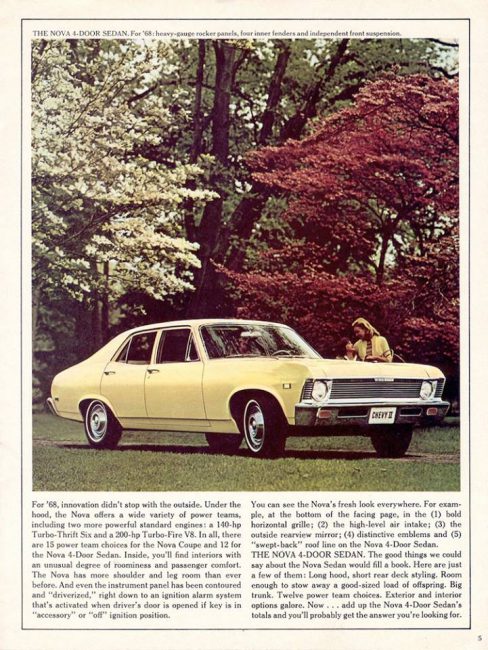
The first-gen 1962-65 Chevy II/Nova and the redesigned 1966-67 version were both very squared off, but the new 1968 model had the same flowing lines and Coke-bottle flanks of the also-new Chevelle line. It was quite an attractive car, both in two- and four-door versions.
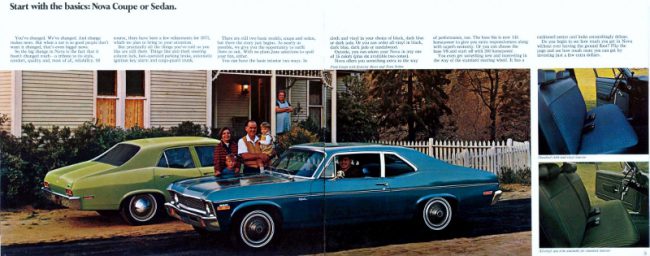
For several years in the early Seventies, the Nova was touted similarly to the VW Type I “Beetle,” in that no major changes were made to styling. Refinement, not change for the sake of change, was the watchword. That continued with the facelifted 1973 models, for the most part.
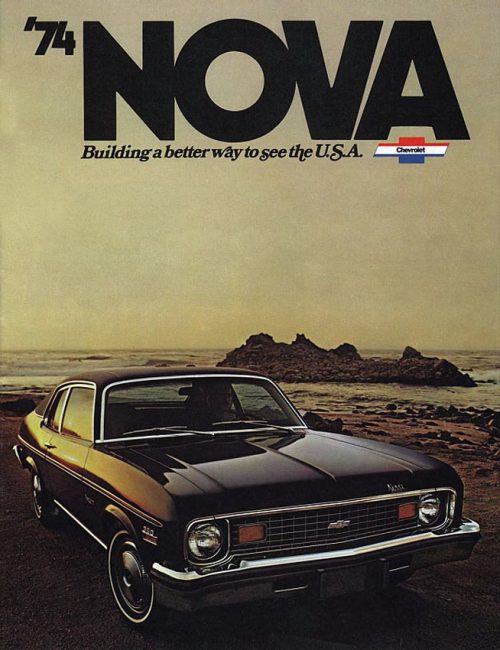
The most obvious change to the ’73 Novas were the much larger chrome 5-mph bumpers. For some reason, both the 1973 Nova and Chevelle/Laguna had large rear bumpers as well, though the Camaro, Impala/Caprice/Bel Air, Monte Carlo and Vega all made due with better-integrated rear bumpers. Perhaps the Nova and Chevelle were designed with 1974’s 5-mph rear bumper mandate in mind?
Of course, every time I see one of these I think of 1973’s Live and Let Die, Roger Moore’s first 007 film, and the Nova police cars attempting–and failing–at catching Bond and Solitaire (the lovely Jane Seymour) in a double-decker bus.
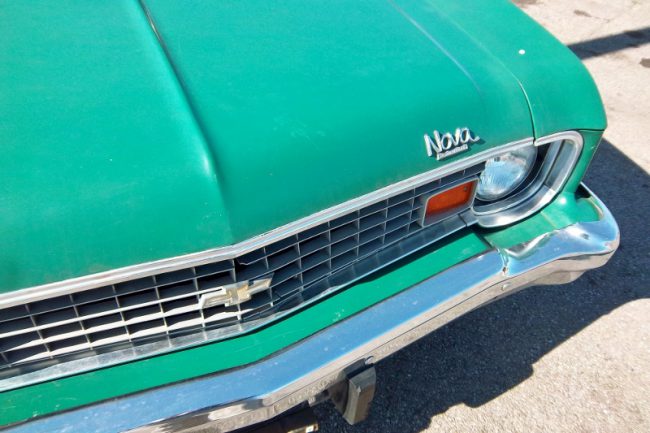
In addition to the bigger bumpers, 1973-74 Novas gained new front and rear fascias, an uplevel Custom series, and a hatchback model. The hatchback was heavily played up in both the brochures and period advertising, but it was never a big seller, compared to the standard two-door coupe.
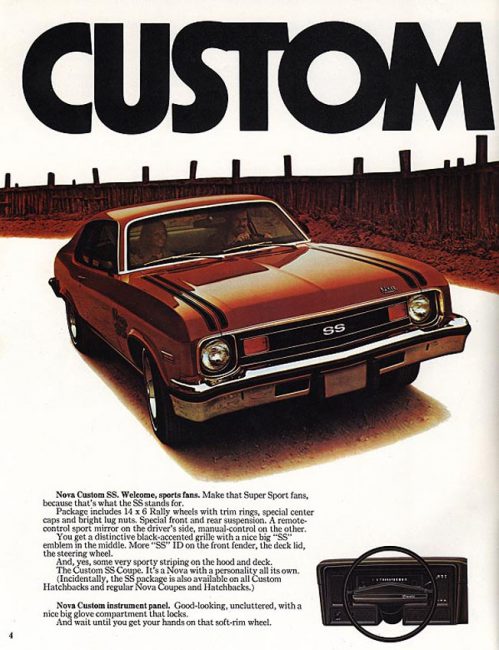
The SS also returned, though by this point it was more of an appearance and handling group than the tire-burning models of the Sixties and early Seventies. They still looked good though, with their six-slot Rally wheels and stripes.
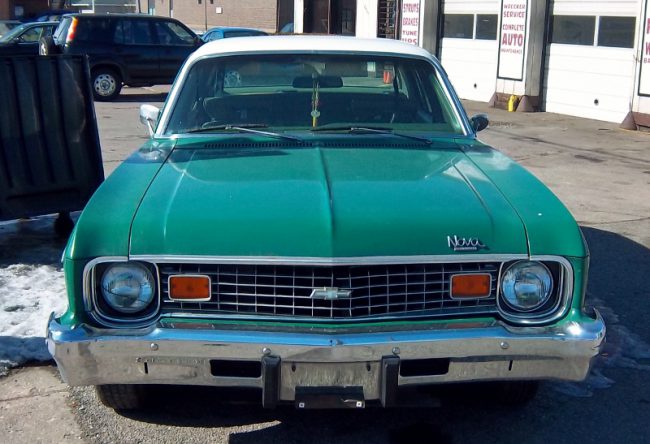
A new, more European-styled Nova was waiting in the wings for 1975, so the ’74 model was largely a re-run. The only obvious way to tell a 1973 from a 1974 is that ’74s added a Chevrolet bowtie to the grille.
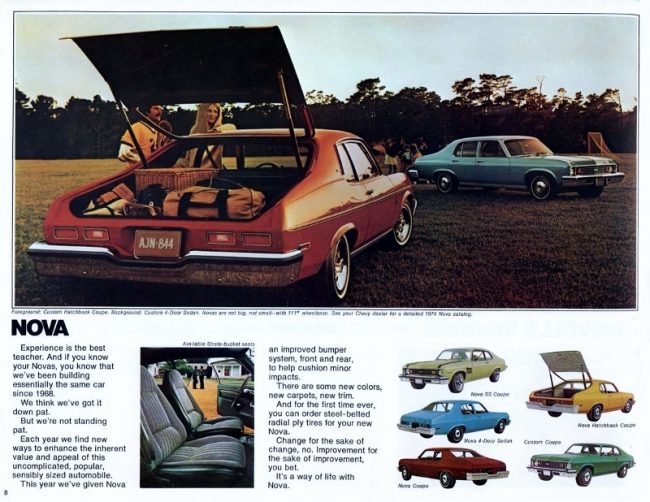
As the 1974s debuted shortly before the 1973 gas crisis, smaller cars got a healthy boost in sales. Suddenly, more folks were looking at Novas, Hornets and Mavericks – and even some of those funny little Japanese cars, for Pete’s sake! But Midwesterners were less likely than folks in New York or California to look at a Datsun or Toyota, so cars like this Nova were a big draw to Chevy showrooms.

Chevrolet took advantage of that fact, playing up the Nova as a good choice for folks used to big cars. As the 1974 Nova brochure cajoled:
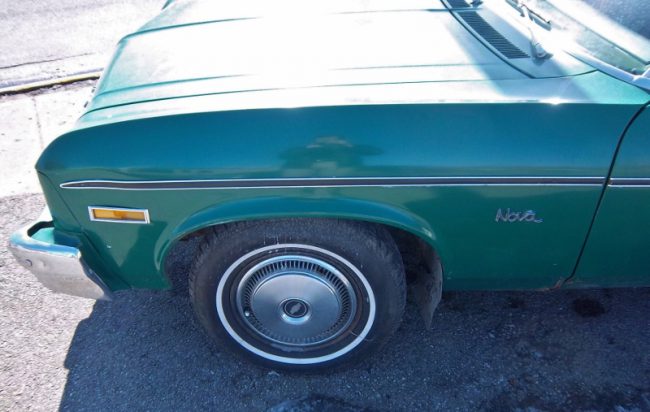
We offer you four-door convenience combined with Nova reliability in a car that’s smaller than many on the road, but still seats six inside. If you’re a “big car man” looking for something smaller and more economical, this might just be it.
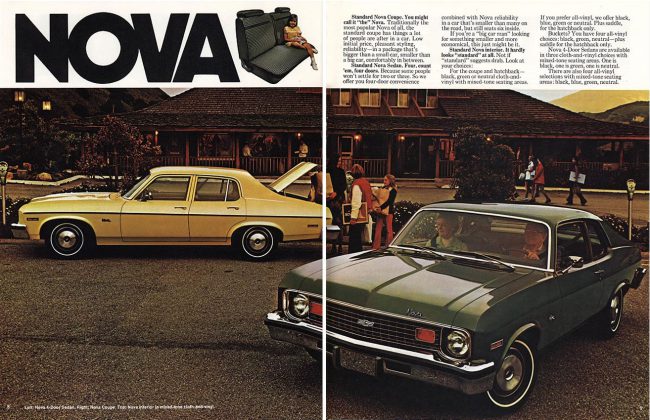
Well, the Nova really was a scaled-down full-size Chevy, but has anyone ever actually seated six passengers in one of these? Sure, it was clearly roomier than a 510 or Corolla of the time and I think five would fit with no problem, but I am skeptical of six people riding comfortably in one of these, despite the 111-inch wheelbase and 72″ width. Maybe if they were really skinny and on exceptionally good terms with one another…

Despite the big bumpers, this was still a rather nice looking car, though this one would have looked better if it had the optional bumper rub strips. Did GM really need to put those bolts in such an obvious place? I suspect it was a ploy to encourage Nova buyers to spring for the extra cost deluxe bumper guards and rub strips. Otherwise, your plain chrome bumpers announced to other motorists what a cheapskate you were.

Being a non-Custom, our featured Nova has a rather plain interior, save for that oh-so-’70s houndstooth upholstery pattern. What did they do, make them out of Herb Tarlek’s sport coats?
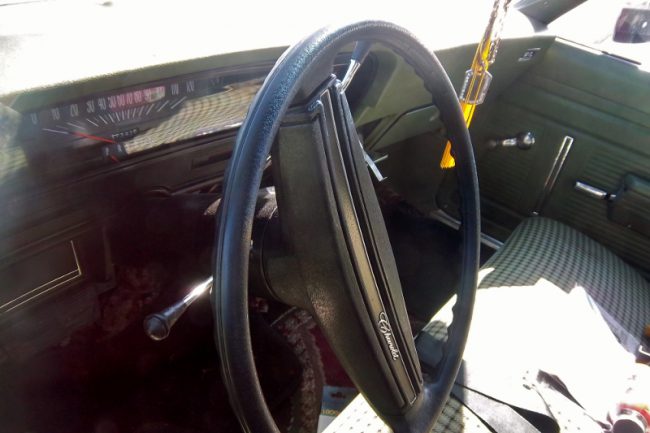
The instrument panel was typical ’70s GM, with a two-spoke steering wheel, column shift (3-on-the-tree, Poweslide or, on V8 models, a THM. I’ve always liked the Chevrolet script on this vintage of Chevrolet. I think it would loook pretty cool on new Impalas and Malibus, though perhaps not on the Camaro.

More green houndstooth awaited rear-seat passengers. Judging from the oblong valve cover on the floor, I am guessing this car has the Turbo-Thrift 250 Six. It was far too long to belong to the 307 or 350 V8s that were optional on Novas of this era.
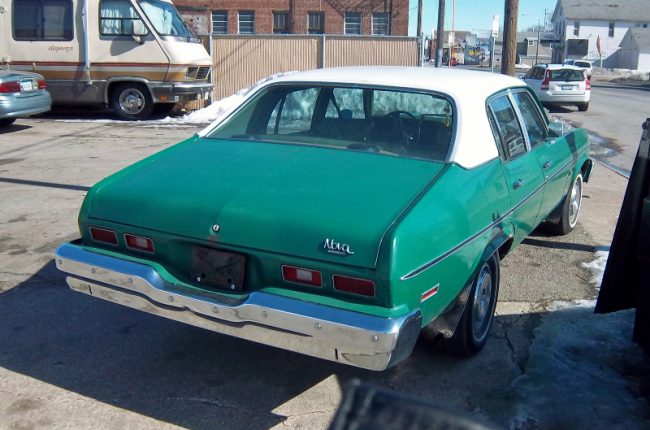
I spotted and photographed this one in downtown Rock Island, on February 23, 2014, at a little corner car lot. It appeared to be for sale, as it had no license plates, and I was impressed with its originality, right down to the factory-appearing paint, full wheel covers and whitewalls.
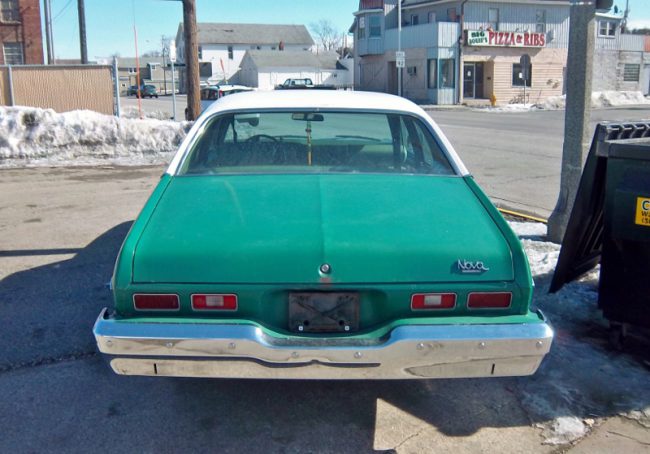
Of course, I loved the green-and-white color combination. And this car does not have a vinyl roof–that is white paint. It too appeared original, but my copy of the 1973 Nova brochure does not list two-tone paint. Was it a factory option, a special order or was this car repainted when the vinyl gave out?
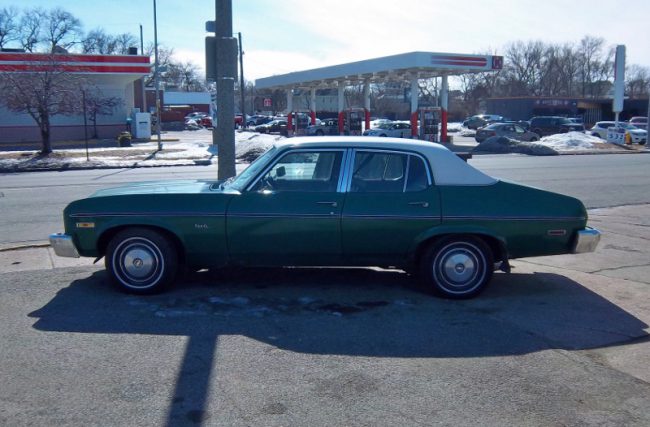
Hopefully this Nova found a good home. At any rate, I never saw the car again, either on the road or at a car show.
One final note. This was all set to go up on Cantankerous Coot back in late 2014. However, I received my final crazy-pants email from the Coot himself not long before this was scheduled to run, so it never did, and had been biding time on my computer until I ran across the Word doc on it while looking for something else recently. So here ’tis, at last, heh!
Live and Let Die bus chase courtesy of Youtube.







16 Comments
Bet they wish the iron duke was ready in time for the gas lines of 1974. The old superthrift four with it’s 70 net horsepower was not enough any more with those heavy bumpers but the iron duke with 85 would have been showroom if not corporate gold that year. Never understood why they let the 75s and up gain so much weight. It was the time to lose weight not gain it.
I can imagine PN’s face when your future articles disappeared from the website’s future publishing cue. Bet he was happy to see your old work remained. He got plenty more mileage from rerunning your contributions
I always associate the full size Chevy’s with Live and Let Die first, to me, this will always be Jules and Vincent’s ride in Pulp Fiction.
Nova
Omega
Ventura
Apollo
At one point somebody at GM put on their thinking cap. Regarding seating six, we were a much skinnier country back in the 70’s, but “comfortably” is debatable. I once drove six of my family 400 miles round trip in my ’66 Falcon 2-door one time because everyone else had bought newer 70’s cars with only 5 seatbelts. I didn’t hear any complaints.
Interesting to compare the 70s Nova with the 60s Jetfire of the previous post. Those early 60s GM compacts were really well appointed and interestingly engineered (turbos, aluminum V-8s, transaxles, IRS, 4 speed manuals) cars that could be optioned to be almost as luxurious as the full-size models of the era (look how nice that Jetfire is inside). Then compare the Jetfire to that 73-74 Nova, which even in its most luxurious package had a very spartan interior, smaller trunk and backseat, and nothing innovative from an engineering point of view (and the Omega wasn’t any better). Detroit in the 60s beat back the imports (except VW), but were slipping badly by the 1970s and opened the door for the Japanese and upscale Europeans.
Actually within a year or so of the 1973-74 X-bodies, after the 1975 restyle you could get a pretty nice Omega SX or Brougham with a split bench and much nicer door panels, around 1975 you could also get the Nova LN or Concours which also had a much nicer interior about on par with mid-level midsize and full size cars.
Remember also that those 1961-1963 compacts actually grew into the intermediate cars in their next generation; they became the Cutlass, LeMans, Skylark in 1964 when they wen BOF and the Malibu was introduced.
Yes I remember the LN and it was a significant upgrade, which I suspect was designed to combat the new “almost as Mercedes” Ford Granada.
The price was almost as Rabbit, as you leave out. A car that was known for it’s world class interior cardboard. Where were the imports in their regular people priced decent interiors. I can only think of the Manta Luxus and some British cars not sold here.
I think that to compare the Olds to the Chevy is not quite apples to apples. The Jetfire was an upscale compact, the Nova was supposed to be an economy car. I would expect plainer materials in Chevy vs. the Olds.
I had a couple of buddies in HS who had this generation of Nova in the late 70’s. Both of their cars were painted in a similar fashion, Greg’s was an actual SS model (with a prepared 350 swapped in), and Dennis’ was a six cylinder model dressed up to look like an SS. However, Dennis eventually did swap in a 307 to keep up a little bit. Frankly, while the SS “mascara” did make these cars look a little better, they were not as lean as the 68-72’s or as clean as the 75-79’s. I liked the looks and function of either side of this generation of Nova.
I’m from a small town in rural Ohio. Our idea of fun on a Friday or Saturday night was to go out on the paved farm roads and drag race each other. Occasionally, an County Mountie would roll through and catch us racing. One evening, my buddy Greg and I were out doing just that when Mountie rolled up on our bumper. Greg floored the little Nova and to my astonishment we pulled away from him.
On the other hand, we were driving like maniacs, without headlights, down these farm roads that weren’t necessarily straight. The Nova was good in a straight line, but by the time we put some distance between us and the cops, Greg had pretty much used up the brakes and tires. We were able to pull into a friend’s parent’s farm and hide the Nova behind the barn a good 200 feet or more off of the road. The brakes were so hot, you could feel the heat and see the smoke rising from them like little smokestacks. I thought for sure we’d be seen, but the cop rolled on past us.
After that experience, I stayed away from the country drags for a while…
Tom,
A Nova? Come back!
A Nova with the 9C1 police package is on my lottery list. Very close to a four door Z28 or TransAm as the GM pony cars were developed from the Nova platform, only the Nova body is stiffer from what I’ve read.
I loved these when new and still turn my head whenever one goes by, just to – day a dark green ’72 4 door rolled past my house…
No longer a common sight .
-Nate
My Driver’s-Ed car!
Except for the paint – my trainer was orange – this could be it. I hated that car – with time, I’ve come to realize it was not the car so much but the circumstances. Our road inspector was an old American-Indian (he made sure we knew it) with zero humor, and with plenty of bottle-time in his past. He had a way of muttering every instruction, and a hair-trigger temper.
And I was often in the back seat with a lovely 16-year-old lass who had no use for me, either.
On to the car. My memories of it were (a) a vague on-center steering feel, characteristic of the first-gen Saganaw variable-ratio box. (b)Every bump in the road would make the floor pan bloop like the bottom of an old oil can. Annoying as hell.
They had no guts, either, but that was typical of all cars of that era. At home, there was a Maverick. Later, I purchased a Super Beetle – with Same-Day Response from the right-side pedal.
A wonderfully-preserved specimen of a working-class car. Which was what Cantankerous Coot was ostensibly founded to showcase; but as we know, the coot has other, hidden agendas.
“They had no guts, either, but that was typical of all cars of that era.”
Actually no ;
I remember drivi9ng i6 powered vehicles all through the 1960’s, 1970’s and 1980’s, many were -so- slow I knew something was amiss and often offered to tune them up and was always agngrily rebuffed by the people in charge ~ looking back I bet they knew damn well and wanted the heaps to be slow so we young ‘uns wouldn’t be thrashing them to death…..
One of the things that made all those millions of GM vehicles so pleasurable back in the day was the quick ‘Tip In’ or throttle response ~ you might be driving a full sizer with a tiny 230CID i6 engine but from a dead stop they always had better off idle response than Fords or MoPars ….
Not fast, no certainly not but .
-Nate
There’s some truth there, for sure. It was a lot more fun over there when the premise was “Hey look at that cool old car.” That’s pretty much gone now.